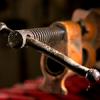Jebediah,
I'm a little confused. Were the scratches there before you started with the Atoma or did they happen after you started using the Atoma?
Assuming they only occurred after you started using the Atoma, I agree that there must be something sharp and hard that's causing the scratches.
If there's no burr on the Atoma, I wonder if there's some random piece of loose grit from your earlier attempts that are still embedded in the surface of the stone. Or on your bench.
Here are some suggestions - in the order I would try them:
1. Until you have this figured out, I would do everything away from your bench to eliminate any possible contamination source. Find a sink and do this under running water or get a tub of water and do this underwater. Most importantly, far away from where you were using sandpaper and the Shapton grits.
2. Keep using the pencil hash marks. Hold the Atoma in one hand and the stone in the other. After 10 or 20 strokes, flip the stone only end to end. After another 10 or 20 strokes, flip the Atoma end to end. After another 10 or 20 strokes, switch hands and repeat the end to end flipping.
3. If the scratches are still there, but less, keep going. Hopefully you'll eventually get below the embedded grit.
4. If you're not flattening both sides of the stone, try flattening the other side and see if the scratches occur there as well. If you have been doing both sides and have scratches on both sides, try flattening the edges of the stones. If the scratches don't appear there as well, it's not the Atoma - it's grit something embedded in your stone.
5. Find someone with soft fingers (child? non-woodworking spouse?) and ask them to feel around the edges of the Atoma and see if they can fell a burr. If you don't have anyone around with soft fingers, use your lips to feel - don't rely on your calloused fingers to try to find this.
6. Wet the stone and get the soft fingered person (or your lips) to feel the surface of the stones to see if you can detect any loose grit on there.
7. Grab your plane blade or chisel with the shiniest edge and try to sharpen it on the 1500 stone. If there's a piece of grit embedded in the stone, you'll see the scratch on the blade.
That's all I have. Good luck.
Steve




 Reply With Quote
Reply With Quote


 )
)
